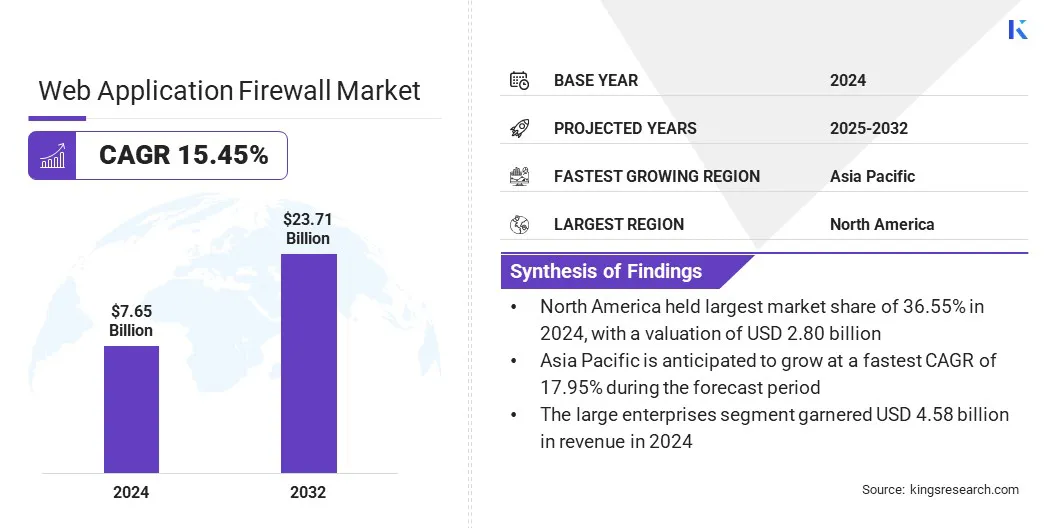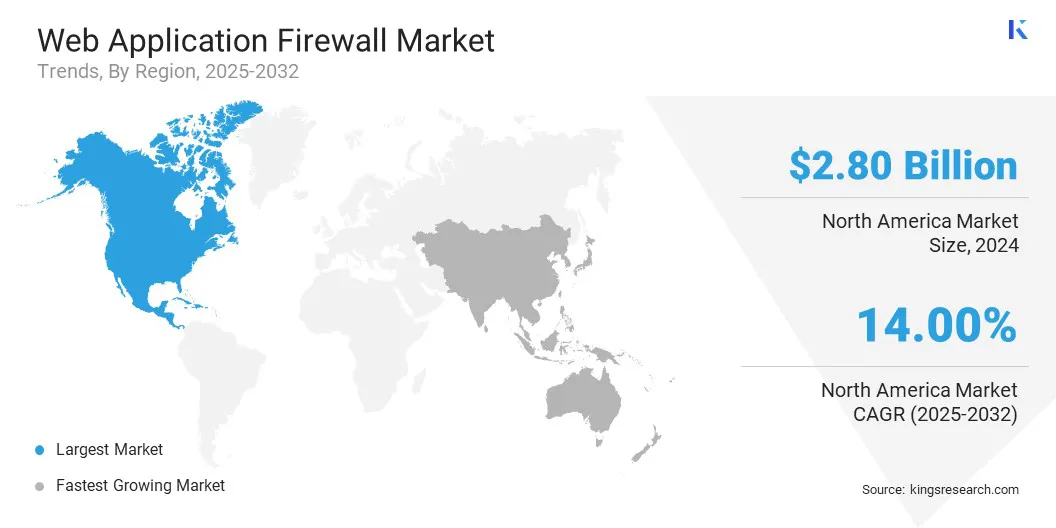buyNow
Web Application Firewall Market
Web Application Firewall Market Size, Share, Growth & Industry Analysis, By Component (Software, Services), By Deployment Mode (Cloud-based, On-premise), By Enterprise Size (Small & Medium-sized Enterprises (SMEs), Large Enterprises), By Industry Vertical, and Regional Analysis, 2025-2032
pages: 190 | baseYear: 2024 | release: July 2025 | author: Versha V.
Market Definition
A Web Application Firewall (WAF) is a security tool that filters and monitors HTTP traffic between a web application and the internet to block malicious activity. The market includes solutions that protect web applications from common threats and vulnerabilities. It covers both cloud-based and on-premise deployments offered as software or integrated appliances.
The market includes services such as support, maintenance, and consulting. Vendors cater to various industries, including banking, retail, healthcare, and IT. Businesses of all sizes adopt WAFs to meet security standards and regulatory requirements.
Web Application Firewall Market Overview
The global web application firewall market size was valued at USD 7.65 billion in 2024 and is projected to grow from USD 8.67 billion in 2025 to USD 23.71 billion by 2032, exhibiting a CAGR of 15.45% during the forecast period.
The market continues to grow, due to the rising frequency of cyberattacks targeting web applications and the increasing demand for data protection across industries. Companies are adopting WAF solutions to safeguard sensitive customer and enterprise data while ensuring compliance with evolving regulatory frameworks.
Key Highlights
- The web application firewall industry size was valued at USD 7.65 billion in 2024.
- The market is projected to grow at a CAGR of 15.45% from 2025 to 2032.
- North America held a market share of 36.55% in 2024, with a valuation of USD 2.80 billion.
- The software segment garnered USD 4.39 billion in revenue in 2024.
- The cloud-based segment is expected to reach USD 15.46 billion by 2032.
- The large enterprises segment is expected to reach USD 12.84 billion by 2032.
- The healthcare & life sciences segment is expected to reach USD 7.62 billion by 2032.
- The market in Asia Pacific is anticipated to grow at a CAGR of 17.95% during the forecast period.
Major companies operating in the web application firewall market are Akamai Technologies, Cloudflare, Inc., F5, Inc., Fortinet, Inc., Barracuda Networks, Inc., Amazon.com, Inc., Microsoft, Alphabet Inc, Radware, Palo Alto Networks, Check Point Software Technologies Ltd., Cisco Systems, Inc., Trend Micro Incorporated, Sophos Limited., and Dell Inc.

The growing need for real-time threat detection is driving the demand for advanced WAF solutions. Enterprises are adopting cloud-based WAF solutions with advanced monitoring and automated response to secure hybrid and multicloud environments. This need for immediate visibility and faster mitigation is accelerating the shift toward intelligent, real-time application security solutions.
- In June 2025, Penta Security launched Cloudbric WMS on AWS Marketplace as a managed service for AWS WAF. The service provides rule optimization, monitoring tools, and expert management to enhance the security and usability of AWS WAF for global users.
Market Driver
Shift Toward Cloud-native Security for Distributed Application Environments
The web application firewall market is growing as enterprises move toward cloud-native security to support hybrid and multicloud deployments. Organizations are modernizing IT infrastructure; however, decentralized environments increase exposure to cyber threats.
Companies are replacing legacy tools with cloud-native WAFs that offer centralized control, real-time protection, and flexible scalability. These modern solutions maintain consistent security policies across cloud platforms without disrupting operations. Vendors are enhancing offerings with automation, low-latency performance, and deeper cloud integration to meet evolving enterprise security demands.
- In June 2025, Fortinet enhanced Lacework FortiCNAPP and expanded the availability of FortiAppSec Cloud and other services in AWS Marketplace. The update strengthens full application life-cycle protection across hybrid and multi-cloud environments, offering unified WAAP capabilities, agentless scanning, real-time alerting, and integrated cloud-native security.
Market Challenge
Traditional WAFs Struggle to Secure Modern Cloud Architectures
A key challenge in the web application firewall market is the limited security coverage of traditional WAFs across hybrid and multicloud environments. Legacy systems lack the flexibility to support decentralized workloads, resulting in inconsistent policy enforcement and reduced visibility into threats. These limitations make it difficult for enterprises to protect applications deployed across diverse platforms.
Companies are introducing cloud-native WAFs designed for distributed infrastructure. These solutions enable centralized control, automated updates, and real-time monitoring. By aligning with dynamic cloud environments, they improve policy consistency, reduce manual effort, and enhance scalability. However, the gap between evolving deployment models and outdated security tools continues to constrain the full effectiveness of application-layer defense in complex environments.
Market Trend
AI-powered threat detection
The web application firewall market is registering a strong shift toward the use of AI to improve threat detection. AI helps analyze traffic patterns, detect anomalies, and respond to unknown attack vectors in real time. This reduces false positives and improves accuracy. AI models identify and block evolving threats, including zero-day exploits and bot traffic.
The technology enables faster response without relying only on rule-based filtering. Organizations benefit from improved protection across web applications and APIs, especially in high-traffic environments. The increasing use of AI supports security teams in managing growing data volumes and complexity while maintaining operational efficiency. This trend addresses the need for intelligent, automated defense in modern digital infrastructure.
- In April 2025, Akamai Technologies, Inc. launched Firewall for AI to secure AI-powered applications, LLMs, and AI-driven APIs. The solution offers multilayered protection, real-time AI threat detection, and proactive risk mitigation. Akamai also introduced API LLM Discovery to enhance API security by identifying GenAI endpoints and enforcing updated security policies.
Web Application Firewall Market Report Snapshot
|
Segmentation |
Details |
|
By Component |
Software (Hardware appliances, Virtual appliances, Cloud-based), Services (Managed Services, Professional Services) |
|
By Deployment Mode |
Cloud-based, On-premise |
|
By Enterprise Size |
Small & Medium-sized Enterprises (SMEs), Large Enterprises |
|
By Industry Vertical |
BFSI, Healthcare & Life Sciences, Retail & E-commerce, IT & Telecommunications, Manufacturing, Others |
|
By Region |
North America: U.S., Canada, Mexico |
|
Europe: France, UK, Spain, Germany, Italy, Russia, Rest of Europe | |
|
Asia-Pacific: China, Japan, India, Australia, ASEAN, South Korea, Rest of Asia-Pacific | |
|
Middle East & Africa: Turkey, U.A.E., Saudi Arabia, South Africa, Rest of Middle East & Africa | |
|
South America: Brazil, Argentina, Rest of South America |
Market Segmentation
- By Component (Software, and Services): The software segment earned USD 4.39 billion in 2024, due to rising adoption of automated threat detection and customizable security rules.
- By Deployment Mode (Cloud-based, and On-premise): The cloud-based segment held 59.34% share of the market in 2024, due to increased migration to cloud infrastructure and demand for scalable security.
- By Enterprise Size (Small & Medium-sized Enterprises (SMEs), and Large Enterprises): The large enterprises segment is projected to reach USD 12.84 billion by 2032, owing to to higher cybersecurity budgets and complex infrastructure needs.
- By Industry Vertical (BFSI, Healthcare & Life Sciences, Retail & E-commerce, IT & Telecommunications, Manufacturing, and Others): The healthcare & life sciences segment is estimated to reach USD 7.62 billion by 2032, owing to strict data protection regulations and rising cyber threats to patient records.
Web Application Firewall Market Regional Analysis
Based on region, the market has been classified into North America, Europe, Asia Pacific, the Middle East & Africa, and South America.

North America web application firewall market share stood at around 36.55% in 2024, with a valuation of USD 2.80 billion. The regional market is driven by the large number of API-based applications and enterprise SaaS platforms in sectors such as fintech, healthtech, and e-commerce.
Many U.S. based companies serve global customers through online platforms, which increase their exposure to web-based threats. The presence of major cloud providers such as AWS, Microsoft Azure, and Google Cloud has supported the adoption of managed WAF solutions. Furthermore, enterprises in the region invest in advanced WAF solutions to secure large-scale digital infrastructure and maintain uninterrupted delivery of online services.
- In April 2025, Akamai Technologies, Inc. introduced App & API Protector Hybrid to expand WAF capabilities for applications and APIs across multicloud, on-premises, and CDN-agnostic environments, allowing organizations to standardize protections, reduce operational overhead, and accelerate cloud transformation without sacrificing security.
The web application firewall industry in Asia Pacific is expected to register the fastest growth, with a projected CAGR of 17.95% over the forecast period. The market is driven by the expanding deployment of WAAP solutions through strategic partnerships between regional IT vendors and cybersecurity providers. These collaborations improve access to WAF technologies designed for local infrastructure and application needs.
Well-established sales networks across the region are enabling faster adoption, particularly among mid-sized enterprises. Organizations are also focusing on innovation to develop WAF solutions that address region-specific web security challenges. As digital platforms expand across key industries, the demand for scalable and secure application protection continues to rise, strengthening the region’s contribution to global market growth.
- In July 2024, Penta Security partnered with Version 2 Digital to expand the distribution of its WAPPLES Web Application & API Protection (WAAP) solution across Hong Kong, Macau, Taiwan, and Singapore, strengthening its presence in the Asian market through Version 2’s regional sales network.
Competitive Landscape
The web application firewall industry is characterized by continuous product development and increasing platform integration. Companies are embedding WAF capabilities into broader Web Application and API Protection (WAAP) solutions to deliver unified security for both web applications and APIs. This integration supports centralized policy control and consistent protection across on-premise and cloud environments.
As enterprises adopt hybrid and multicloud infrastructure, vendors are prioritizing scalable WAF deployments that maintain performance without increasing complexity.
Companies are also focusing on mergers and acquisitions to expand their technology portfolios, strengthen WAAP offerings, and accelerate entry into new regional and vertical markets. These strategies reflect the growing demand for efficient, adaptable, and high-performance application security solutions.
- In February 2025, A10 Networks acquired ThreatX Protect to expand its cybersecurity portfolio with a WAAP solution. The acquisition includes API protection, bot management, and a next-generation web application firewall, aligning with A10’s strategy to secure applications and APIs across hybrid environments.
Key Companies in Web Application Firewall Market:
- Akamai Technologies
- Cloudflare, Inc.
- F5, Inc.
- Fortinet, Inc.
- Barracuda Networks, Inc.
- Amazon.com, Inc.
- Microsoft
- Alphabet Inc
- Radware
- Palo Alto Networks
- Check Point Software Technologies Ltd.
- Cisco Systems, Inc.
- Trend Micro Incorporated
- Sophos Limited.
- Dell Inc.
Recent Developments (Partnership/Collaboration)
- In July 2025, Radware partnered with MAIRE to integrate its AI-powered Cloud Application Protection Services, including web application firewall, bot detection, and DDoS protection, into MAIRE’s managed services portfolio. The partnership aims to enhance application-layer security and support global enterprises facing complex threats and operational challenges.
- In July 2024, Barracuda Networks, Inc. collaborated with AWS to expand routes to market and accelerate customer migration to the cloud. The agreement supports the deployment of Barracuda’s cloud-first security solutions, including WAF, in AWS Marketplace and reinforces their joint commitment to simplifying access to scalable, cloud-based security.
